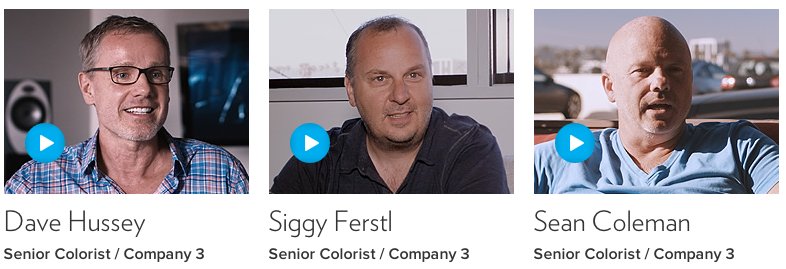How To Become A Better Colorist
If you want to become a better colorist this year then learning from some of the world’s best colorists would definitely be a smart idea. In this round up of colour grading craft resources there are some great insights to be found from many working professionals.
UPDATE FEBRUARY 2021 – HOW TO BECOME A BETTER COLORIST
I have taken (most) of the best resources in this post and combined with with two fistfuls of the latest and greatest interviews with some of the industry’s most sought-after colorists in this whole new post for 2021 – > How to Become a Better Colorist < – so head there instead!
Original Post…
This advert for Lacoste, The Big Leap, is graded by Jean-Clément Soret, a multi-award winning colorist who has been in the business for 26 years, 17 of which he has spent grading at MPC. Dan Moran selected several of Jean’s commercials for his run down of the best commercials in 2014 over on Mixing Light.com. It’s always interesting to see what colour grading work other colorists admire.
In this video from BVE you can hear Jean Clément talk through his working process and shot by shot breakdowns of some of his feature film grading work in this 35 minute presentation. His grading system of choice? Baselight. Jean is interviewed by Little Black Book on his craft and creativity.
LBB> On a ‘typical’ commercial, what’s your starting point for finding the right ‘look’?
JCS> Usually I try to give a true representation of what the Director of Photography has shot. And then I see what they’ve actually got and then I gather a lot of opinions around me and I try to synthesise all of that to bring us to a starting point. Then we have a bit of a debate over how we can build on that. That gives us a good base to start with and it means that no one is surprised by the end of the process.
Filmlight, the makers of the Baselight colour grading system also have an interview with Jean-Clément as part of their extensive ‘Meet The Colorist’ series.
What advice would you give to someone looking to start a career as a colorist?
I regularly train or mentor beginners and feel that MPC is a fantastic place to learn, mostly due to its international reputation. We value the quality and the attention to detail. To someone looking to start a career as a colourist I’d say that it is important to forge your experience in an enjoyable place, and to get as much feedback from experienced colourists as you can.
Grading Birdman – a one shot feature film
Birdman is lined up for plenty of awards, and it’s one-shot structure makes it all the more interesting. In this short clip from Variety you can hear Technicolor’s colorist Steve Scott. At just under 4 minutes it’s still got plenty of insights in it, like the importance of being able to track 100’s of windows simultaneously and hide all your transitions in the films many whip pans.
20 minutes with Colorist Stephen Nakamura
What’s most upsetting about this 20 minute two part interview with one of the world’s best colorists, Stephen Nakamura, whose 93 feature film credits are a hit list of Hollywood’s output over the past few decades, is that the interviewer has not a great idea who he is, or the intricacies of colour grading but still well worth a listen for the great answers from Stephen.
In this (non-embeddable) inside look at Company 3 (where Nakamura and some of the world’s other best colorists work) there are some great choice quotes from Stephen about using color correction to tell the story, to create a brand and define an era.
Through color correction we can create signature looks, almost like branding, when you look at movies like 300, or even back in the day movies like the Godfather, which was a very very dark movie, lots of shadows, people remember that movie for the look that was created at the time. – Stephen Nakamura
Another source of insights from Company 3’s top colorists is the Blackmagic Design DaVinci Resolve page which has these three interviews on it. Well worth a watch.
UPDATE – Kylee Wall from Creative Cow has 5 questions with Stephen Nakamura on his work on Ridley Scott’s Exodus Gods and Kings using DaVinci Resolve’s 3D colour grading capabilities. It’s a short interview but definitely well worth a read.
What tools inside DaVinci Resolve helped you accomplish this color grade?
There’s a highlight adjustment tool in the Color Match function that was recently added which was extremely helpful on this movie. What it basically does is it allows you to suppress the highlights to an extent, preserving details while we’re brightening the picture to make it look appropriately bright for actors’ faces at 3.5 fL in 3D. Typically we grade in 3D at 3.5 fL and when you’re grading people, the key side of the actor’s faces is what needs to look good.
Crafting the Narrative Through Colour Grading
If you jump to 9.20 in this Moviola/Assimilate scratch webinar you can hear french colorist Jean-Michel Petit discuss his work on the low-budget feature film The Lunchbox and how he went about creating a non-Bollywood look that helped to support the film’s character development. It’s interesting to see him talk through some of the film’s challenging scenes.
What It’s Like To Be A Colorist on Elysium
In this very personal Creative Mornings talk from Vancover based colorist Andrea Chlebak you can get a good sense of her journey into colour grading and her work on Elysium. Jump to about 16 minutes in for the more grading focused part of the talk and 20 minutes in for the Elysium breakdowns. For more from Andrea and a deeper look into the film’s VFX work check out this previous post.
Colorists on Colour Grading Commercials and Feature Films
Shoot online has a fairly lengthy article that is half focused on MPC’s US Creative Director and colorist Mark Gethin and half a round up of a collection of various insights from colorists around the world. Gethin graded eight of 2014’s Superbowl spots, including Coca Cola’s “It’s beautiful” above and recently graded feature film The Hundred Foot Journey.
The feature and commercial disciplines are distinctly different from a color grading standpoint. “Obviously with just 30 or 60 seconds, every shot has to be as perfect as it can be,” related Gethin. “For a feature film, there are thousands of shots and for a colorist the strokes are a lot broader. You’re not as specific with each shot. You can’t do that, be that specific, with a feature-length movie–you’d be there for months on end. It takes a different skillset, a different concentration. I had three weeks to grade this last movie. The other big difference is that there are a lot of people involved in a commercial during the color grading. You can have 10 people in the suite. Your work is scrutinized by different people. For a feature, though, a lot of work is done unattended. People tend to come and go. ”
If you’ve ever wondered what it’s like to grade a Hollywood blockbuster like Rush or a low-budget indie then this quick round up of further reading will have you covered.
Colour Grading Rush on Resolve | VFX on Rush | Grading Need For Speed Article 1 – Article 2 | Grading Debut British Feature – Blood Cells | Colour Grading Australian Indie Feature – Circle of Lies | Grading X-Men Days of Future Past | Grading Indie Feature – The Living | Grading a Film look from Red Epic Footage |
“We didn’t have the budget to shoot 35mm, but our goal was to create the look and feel of 35mm… First and foremost, they wanted a very filmic approach to keeping the image natural, smooth and, most importantly, beautiful,” recalls Arnold. “We weren’t pushing in a hyper digital direction. Autumn’s photography was awesome, a unique look with a consistency of tonality — it was in a very warm place with naturalistic skin tones.”
Colour Grading A TV Series
Coronation Street is the world’s longest running continuous TV series and recently employed Filmlight’s Baselight system. The video above is part of Filmlight’s case study on their ‘renderless’ workflow and demonstrates Baselights’s interoperability with Avid.
In the following articles you can essentially pick your favourite show and see what it takes to colour grade in these interviews and case studies…
Arrested Development Article 1 – Article 2 | Colour Grading True Blood | The Many Looks of Comedy Central’s Key and Peele | Onlining Suits and Covert Affairs | Grading House of Cards in 4K | Colour Grading Modern Family Article 1 – Article 2 | The Challenge of Grading a Culinary Travel Show







A lot of the links are not available anymore…
Hey Bea, I’ll try and find these videos – the Jean-Clement Soret ones seem to have vanished from the internet.
I would recommend looking through the colour grading and DaVinci Resolve categories for more recent info.
Fantastic post !! very inspiring 😉
Thanks
Awesome round up Jonny!
Thanks Matt! Do have a rummage in the colour grading category (list on right in the side bar) for similar resources…
Very nice article, did a bad color graded short film gave you the idea to make this article ?
Mike